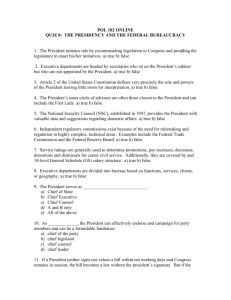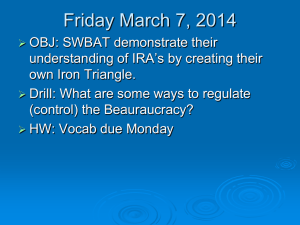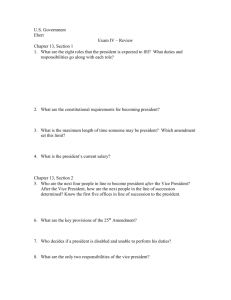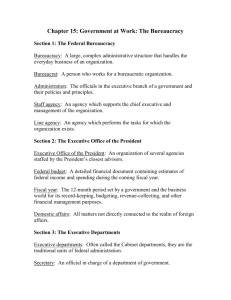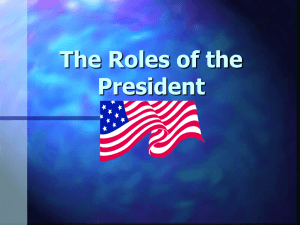Chapter 6 The Executive Branch - Waverly
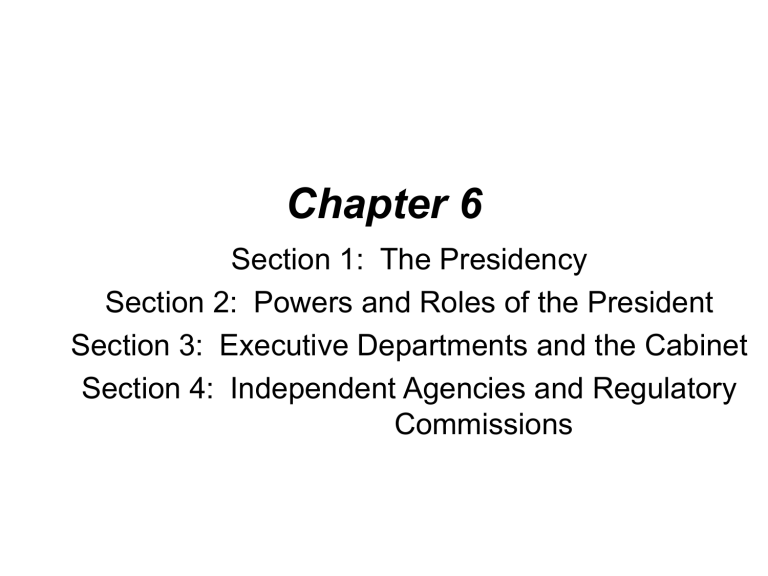
Chapter 6
The Executive Branch
Section 2: Powers and Roles of the President
Section 3: Executive Departments and the Cabinet
Section 4: Independent Agencies and Regulatory
Commissions
Section 1: The Presidency
The Main Idea
The president and the vice president are required to have certain qualifications.
Reading Focus
• What are the qualifications and terms of office for the presidency?
• What are the duties of the vice president?
• What are the rules of succession for the presidency?
Section 1: The Presidency
Qualifications for the presidency:
• Native born U.S. citizen
• At least 35 years of age
• A resident of the United States for at least
14 years
The Electoral College & Qualifications for President [02:26]
Section 1: The Presidency
Terms of office:
• Four year term and may be elected to a second term
• Salary of $400,000 per year plus $50,000 nontaxable allowance
Becoming the President [03:16]
Section 1: The Presidency
Duties and terms of office of the vice president:
• Takes over if the president dies, resigns, or is removed from office
• Presides over the Senate
• Must meet the same constitutional qualifications as the president
• Salary of $186,300 per year plus $10,000 taxable allowance
Section 1: The Presidency
The order of presidential succession:
• The vice president
• The Speaker of the House
• The president pro tempore of the Senate
• Members of the president’s cabinet in the order in which their departments were created
SECTION 1
Question: What are the term of office and the duties of the vice president?
Term of
Office
four years
Vice President
Duties
preside over the Senate
remain prepared to assume presidency
help presidential candidate get elected
Section 2: Powers and Roles of the President
The Main Idea
The powers and roles of the U.S. president affect not only the citizens of the United
States but also people throughout the world.
Reading Focus
• What are some of the leadership roles of the president?
• What powers does the president have?
Section 2: Powers and Roles of the President
The President and the
Legislative Process
• Recommends laws to Congress in speeches, writing, or through State of the
Union Address
• Sends Congress an economic message
• Influences legislation with veto power
Section 2: Powers and Roles of the President
Congress and the Commander in Chief
• Only Congress can declare war.
• The president has the power to send troops into foreign lands.
• 1973 — War Powers Act: requires troops to be recalled within 60 days unless approved by Congress to stay longer
Section 2: Powers and Roles of the President
President’s duties as foreign-policy leader and chief of state:
• Appoints officials to represent the United States abroad
• Travels to foreign nations to meet with leaders and representatives of other countries
• Serves as the nation’s chief diplomat and assumes final responsibility for treaties
• Symbolizes the United States and its people
• Performs ceremonial duties
SECTION 2
Question: What are the duties of the president as foreign-policy leader and chief of state?
President’s Duties as Foreign Policy Leader and Chief
Chief of State of State
secure friendly relations with foreign governments
preserve the security of the United States
appoint officials to represent the United States in foreign countries
meet with leaders of foreign countries
travel abroad to meet with foreign leaders
assume responsibility for treaties with foreign countries
Section 3: Executive Departments and the Cabinet
The Main Idea
The executive branch of the U.S. government is divided into several departments, each of which has certain duties.
Reading Focus
• What is the Executive Office of the President, and what is the cabinet?
• What are the purposes of the Department of
State and the Department of Defense?
• What are the other executive departments in the federal government?
Executive Branch People [03:28]
Section 3: Executive Departments and the Cabinet
The Executive Office of the President
• Established in 1939 and reorganized by each president
• Contains agencies and offices that advise the president on current issues
• The White House Office keeps the presidential schedule, writes speeches, and maintains relations with Congress, the press, and the public.
Section 3: Executive Departments and the Cabinet
The 15 executive departments work to improve life for all Americans.
Department of:
• Agriculture (USDA)
• Commerce (DOC)
• Defense (DOD)
• Education (ED)
• Energy (DOE)
• Health and Human Services
(HHS)
• Homeland Security (DHS)*
* newest executive department
• Housing and Urban
Development (HUD)
• Justice (DOJ)
• Labor (DOL)
• State (DOS)
• Interior (DOI)
• Treasury
• Transportation (DOT)
• Veterans Affairs (VA)
SECTION 3
Question: What are the fourteen department secretaries included in the president’s cabinet?
Secretary of State
Secretary of Treasury
Attorney General
Secretary of the Interior
Secretary of Agriculture
Secretary of Commerce
Secretary of Labor
Secretary of Defense
Cabinet Members
Secretary of Health and Human Services
Secretary of Housing and Urban
Development
Secretary of Transportation
Secretary of Energy
Secretary of Education
Secretary of Veterans Affairs
Secretary of Homeland Security
Section 4: Independent Agencies and Regulatory Commissions
The Main Idea
• The Independent Agencies and Regulatory
Commissions of the U.S. government perform specialized duties.
Reading Focus
• What are some examples of independent agencies, and what duties do they perform?
• What are regulatory commissions, and who runs them?
• What makes up the federal bureaucracy?
Running the Government [01:31]
Section 4: Independent Agencies and Regulatory Commissions
Independent Agencies
• Perform specialized duties that do not fit into regular departments
• Some serve all of the departments and some assist the work of the entire government.
• Examples:
– U.S. Commission on Civil Rights
– Farm Credit Administration
– Small Business Administration
– National Aeronautics and Space Administration
Section 4: Independent Agencies and Regulatory Commissions
Regulatory Commissions
• Independent agencies make rules and bring violators to court.
• Commission heads are appointed by the president and approved by Congress to serve long terms.
• Commissions are independent in order to freely do their jobs.
Section 4: Independent Agencies and Regulatory Commissions
Regulatory Commissions
(continued)
• Examples:
– Federal Election Commission
– Consumer Product Safety Commission
– Securities and Exchange Commission
– National Labor Relations Board
Executive Bureaucracies [02:19]
Section 4: Independent Agencies and Regulatory Commissions
The Federal Bureaucracy
• Formed by the departments and agencies of the executive branch
• Almost 3 million workers
• Operates under heavy rules and regulations that create “red tape” but allow the executive branch to function
SECTION 4
Question: What are some of the independent agencies and regulatory commissions of the federal government?
Independent Agencies
Commission on Civil Rights
Farm Credit Administration
Regulatory Commissions
Federal Election Commission
Consumer Product Safety Commission
Securities and Exchange Commission
National Labor Relations Board
National Aeronautics and Space Administration
Small Business Administration
Office of Personnel Management
General Services Administration
Chapter 6 Wrap-Up
1. What is the vice president’s role in the government?
2. What limitation did the Twenty-second Amendment place on the terms of the presidency?
3. What is the purpose of the State of the Union Address?
4. How does the president participate in the legislative process?
5. How does the Executive Office of the President serve the president?
6. What other position do the executive department heads hold?
7. Why are the independent agencies separate from the executive departments?


